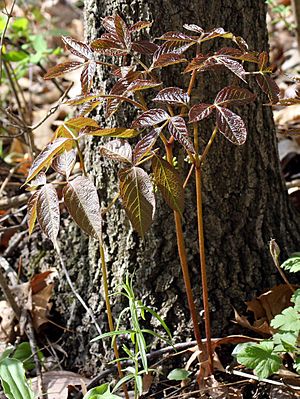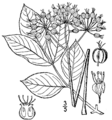Wild sarsaparilla facts for kids
Quick facts for kids Wild sarsaparilla |
|
|---|---|
 |
|
| Scientific classification | |
| Genus: |
Aralia
|
| Species: |
nudicaulis
|
The Aralia nudicaulis plant is often called wild sarsaparilla. It also has other names like false sarsaparilla or rabbit root. This flowering plant grows in northern and eastern North America. It usually reaches a height of about 30 to 60 centimeters (1 to 2 feet). It grows from stems that spread underground.
Contents
About Wild Sarsaparilla
In the spring, the underground stems of wild sarsaparilla grow large leaves. These leaves have many smaller parts, like tiny leaves, and have finely toothed edges. Small white flowers grow in round groups, about 4 to 5 centimeters (1.5 to 2 inches) wide. These flowers grow on tall stalks that are about the same height as the leaves.
The flowers bloom from May to July. After blooming, they turn into purple-black berries that you can eat. The leaves of the plant dry up in the summer before the berries are fully ripe. The berries have a slightly spicy and sweet taste.
Plant Structure
The main stem of the plant grows straight up from the ground. It then splits into three smaller stems that spread out. Each of these smaller stems has about 3 to 7 leaflets, but most often 5. These leaflets are oval-shaped, pointed, and have saw-like edges. They are green in color.
Even though it looks like many small leaves, all the leaflets on one plant are actually part of one big leaf. The small stems connecting the leaflets are called rachis. This way of growing is called "doubly compound." Sometimes, some leaflets can even split again, making a "triply compound" pattern.
Comparing with Similar Plants
Wild sarsaparilla looks a bit like another plant called Aralia hispida, or Bristly Sarsaparilla. Bristly Sarsaparilla is a little bigger. Its stems are covered with tiny, stiff hairs, which is why it's called "bristly." Wild sarsaparilla, on the other hand, has smooth stems.
Where Wild Sarsaparilla Grows
This plant is very common in certain types of forests in North America. It is often found in Northern Hardwood Forests, Beech-Maple Forests, and Oak-Hickory Forests. It also grows in the Interior Cedar Hemlock forest ecosystem in central and southern British Columbia. Because it is so common, it helps scientists know what kind of forest they are in.
Wild Sarsaparilla vs. Poison Ivy
Sometimes, wild sarsaparilla can be mistaken for poison ivy. This is because it can also grow with groups of three leaflets. However, there's an easy way to tell them apart. Wild sarsaparilla does not have a woody base like poison ivy. Also, its leaves have fine teeth along their edges, which poison ivy leaves do not.
Traditional Uses
The roots of wild sarsaparilla have been used in traditional medicine. People used them as a substitute for true Sarsaparilla plants (from the Smilax family).
Images for kids
See also
 In Spanish: Aralia nudicaulis para niños
In Spanish: Aralia nudicaulis para niños





